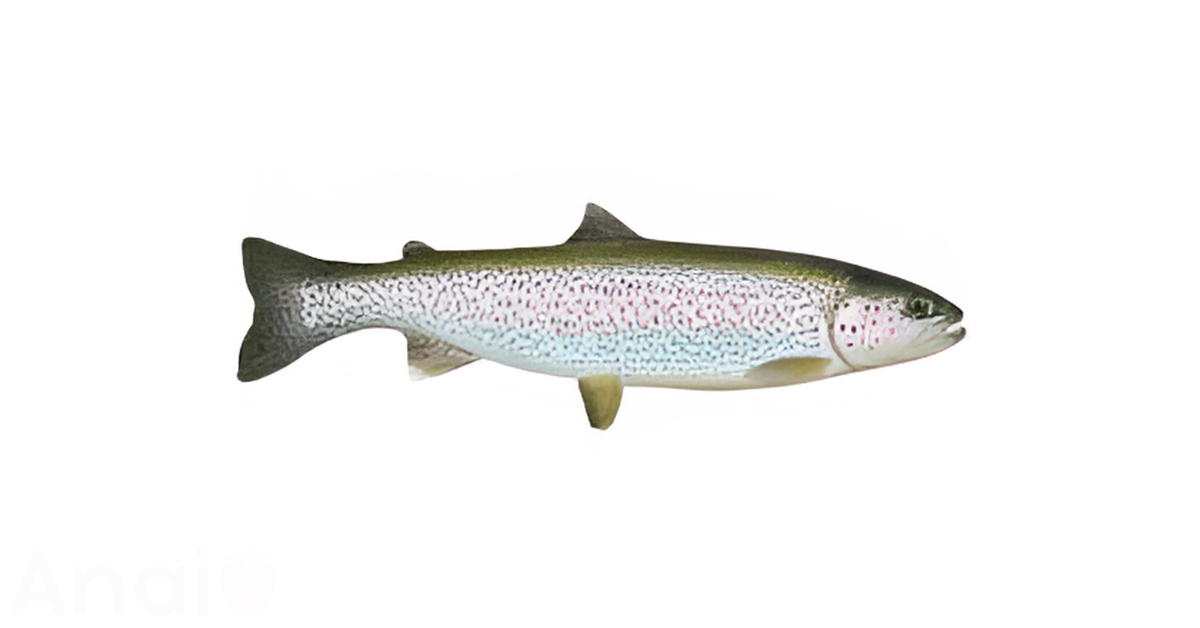Are Trouts Good for You?
Yes, trout is exceptionally good for you. This popular freshwater fish is packed with high-quality protein, healthy fats, and essential vitamins and minerals. It is considered a “clean fish” because it contains very low levels of mercury and other environmental contaminants, making it a safe and healthy choice for regular consumption (Joseph, 2023). Trout is particularly valued for its high concentration of omega-3 fatty acids, which are crucial for heart and brain health. A single serving provides a significant amount of your daily vitamin D and B12 needs.
This article will expand on topics such as 10 research-backed health benefits of trout, trout nutrition facts, trout risks and side effects, trout substitutes, popular trout diets, trout storage tips, 9 unique trout home remedies, trout and weight management, and trout for health conditions. All information presented is current as of December 2025.
10 Research-backed Health Benefits of Trouts
Trout is a nutritional powerhouse. Its health benefits are not just anecdotal; they are supported by scientific research. Each benefit listed below is fact-checked and backed by data from nutritional science and health studies, highlighting why this fish is a smart addition to any diet.
1. Excellent Source of High-Quality Protein
Trout is an incredible source of lean, high-quality protein, which is essential for building and repairing muscle, skin, and bones. A single 100-gram (3.5-ounce) serving of trout provides approximately 20.5 grams of protein, which is about 37% of the recommended daily intake (Joseph, 2023; Rudrappa, 2025). Including protein-rich foods like trout can also help you feel fuller for longer, which can aid in weight management (Proietti, 2023).
2. Rich in Heart-Healthy Omega-3 Fatty Acids
Trout is loaded with the omega-3 fatty acids EPA and DHA, which are vital for cardiovascular health. A typical trout fillet (159 grams) contains around 1,291 mg of omega-3s (Joseph, 2023). Studies show that these fatty acids can significantly lower blood pressure, reduce triglycerides, and slow the growth of arterial plaque (Lindberg, 2020). The American Heart Association recommends eating at least two servings of oily fish like trout per week to meet your omega-3 needs and reduce the risk of heart attack and stroke (Rudrappa, 2025).
3. Promotes Brain Health
The same omega-3 fatty acids that protect your heart are also crucial for your brain. Omega-3s are essential for healthy brain development and function. During pregnancy, for example, they play a vital role in the brain development of the fetus (Lindberg, 2020). Regular consumption of omega-3-rich fish like trout has been linked to improved cognitive function and a lower risk of neurodegenerative diseases.
4. Packed With Vitamin D
Trout is one of the few foods that are naturally rich in vitamin D, often called the “sunshine vitamin.” A 3-ounce serving of rainbow trout contains approximately 645 IU of vitamin D, which is over 80% of the daily recommended value (Lindberg, 2020). Vitamin D is critical for bone health because it helps the body absorb calcium. It also plays important roles in immune function and reducing inflammation.
5. Significant Source of Vitamin B12
Vitamin B12 is vital for DNA synthesis, red blood cell formation, and proper nerve function. Trout is an outstanding source of this nutrient. A single trout fillet provides about 7.1 mcg of B12, which is more than 100% of the recommended daily intake (Joseph, 2023). This makes trout an excellent food for preventing vitamin B12 deficiency and supporting overall energy levels.
6. Helps Reduce Inflammation
Chronic inflammation is a root cause of many serious conditions, including heart disease and arthritis. The omega-3 fatty acids found in trout have powerful anti-inflammatory properties (Proietti, 2023). By incorporating trout into your diet, you can help your body naturally manage its inflammatory response and promote overall well-being.
7. May Lower Risk of Chronic Diseases
The powerful combination of high-quality protein, healthy fats, vitamins, and minerals in trout helps protect against a range of chronic diseases. Its omega-3 content is linked to a lower risk of heart disease and stroke, while its lean protein can help prevent obesity and diabetes (Proietti, 2023).
8. Provides Essential Minerals like Selenium
Trout is a good source of selenium, a mineral that acts as a powerful antioxidant. A single trout fillet offers about 20 mcg of selenium, which is nearly 30% of the recommended daily intake (Joseph, 2023). Selenium helps protect the body from damage caused by oxidative stress and plays a key role in thyroid health and immune function.
9. Good Source of Potassium
Potassium is an important mineral and electrolyte that helps regulate blood pressure and fluid balance. Many people do not get enough potassium in their diets. A trout fillet provides 765 mg of potassium, which is about 22% of the recommended daily intake (Joseph, 2023). Increasing potassium intake while managing sodium is a key strategy for maintaining healthy blood pressure levels.
10. Considered a ‘Clean’ Fish with Low Mercury
One of the biggest advantages of eating trout is that it is considered a “clean fish”. Data shows that freshwater trout has a mean mercury concentration of just 0.071 parts per million (PPM), placing it among the fish with the lowest mercury levels (Joseph, 2023). This makes it a safe and healthy option for everyone, including pregnant women, who can enjoy it multiple times a week without the risks associated with high-mercury fish.
Trout Nutrition Facts
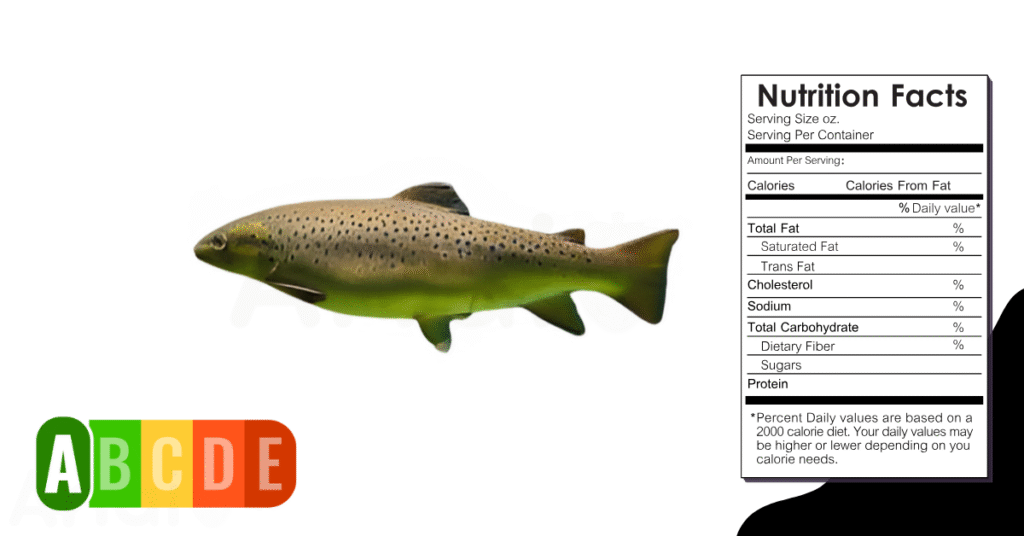
The many health benefits of trout can be further explained through their impressive nutrition facts, as analyzed in detail below.
Trout nutrition table
The following table provides a detailed look at the nutritional profile of trout, based on a standard serving size of 3 ounces (85g) and per 100 grams.
| Nutrient | Per Serving (3 oz) | DRI % (Serving) | Per 100 grams | DRI % (100 g) |
|---|---|---|---|---|
| Calories | 126 | 6.3% | 148 Kcal | 7.4% |
| Protein | 17.7 g | 35% | 20.77 g | 37% |
| Carbs | 0 g | 0% | 0 g | 0% |
| Total Fat | 5.6 g | 8.6% | 6.61 g | 10% |
| Cholesterol | 0 mg | 0% | 0 mg | 0% |
How many calories are in trouts?
Trout is a relatively low-calorie fish, making it an excellent choice for weight management.
A 100-gram portion of trout contains just 148 calories, which is about 7.4% of the daily recommended intake for an average adult. A standard 3-ounce (85g) serving has even fewer, at around 126 calories. To burn off 148 calories, you would need to do approximately 15 minutes of jogging or about 35 minutes of walking.
How much protein is in trouts?
Trout is a protein powerhouse.
Protein is crucial for muscle repair, immune function, and overall body maintenance. A 100-gram serving of trout delivers 20.77 grams of high-quality protein. This accounts for 37% of your recommended daily intake. The protein in trout is also complete, meaning it provides all the essential amino acids your body needs.
How many carbs are in trouts?
Trout is a carb-free food.
A serving of trout contains 0 grams of carbohydrates, sugars, or fiber. This makes it an ideal food for low-carb or ketogenic diets, as it provides energy from protein and healthy fats without impacting blood sugar levels.
How much fat is in trouts?
Trout contains healthy fats, particularly omega-3s. A 100-gram portion has 6.61 grams of total fat, which is about 10% of the daily value. This fat content is what classifies it as an oily fish, and it’s where many of the health benefits come from.
The fat in trout is composed of healthy unsaturated fats, with very little saturated fat.
| Fat Type | Amount per 100g |
|---|---|
| Total Fat | 3.5 g |
| Saturated Fat | 0.7 g |
| Monounsaturated Fat (MUFAs) | 1.1 g |
| Polyunsaturated Fat (PUFAs) | 1.2 g |
Are trouts high in cholesterol?
According to USDA data, trout contains 0 mg of cholesterol (Rudrappa, 2025). This makes it an excellent choice for those monitoring their cholesterol intake.
Minerals in trouts
Trout is a good source of several essential minerals that are vital for bodily functions.
| Mineral | Amount per 100g | Health Benefit |
|---|---|---|
| Phosphorus | 245 mg | Key for bone health, energy production, and cell repair. |
| Potassium | 361 mg | Helps regulate blood pressure, fluid balance, and nerve signals. |
| Selenium | 12.6 mcg | A powerful antioxidant that supports immune function and thyroid health. |
| Iron | 1.50 mg | Essential for creating red blood cells and preventing anemia. |
The mineral profile of trout makes it particularly beneficial for bone strength, cardiovascular health, and antioxidant protection. Phosphorus works with calcium to build strong bones, while potassium helps to counterbalance sodium and maintain healthy blood pressure.
Vitamins in trouts
Trout provides an impressive array of vitamins, especially B vitamins and fat-soluble vitamins like D.
| Vitamin | Amount per 100g | Health Benefit |
|---|---|---|
| Vitamin D | 155 IU | Crucial for calcium absorption, bone health, and immune support. |
| Vitamin B12 | 4.5 mcg | Essential for nerve function, red blood cell formation, and DNA synthesis. |
| Niacin (B3) | 4.5 mg | Helps convert food into energy and supports skin and nerve health. |
| Vitamin B6 | 0.2 mg | Important for brain development and immune function. |
Trout is one of the best dietary sources of both Vitamin D and Vitamin B12. A single 100-gram serving provides 106% of the RDI for Vitamin D and 74% for Vitamin B12 (Joseph, 2023). This makes it incredibly valuable, as many people are deficient in these critical nutrients.
Trouts Risks and Side Effects
While trout is a very healthy fish, some individuals may experience adverse reactions. Fish allergies are one of the more common food allergies, affecting about 1% of the U.S. population (Enticare ENT, 2024). This type of allergy is a reaction to the protein parvalbumin, found in many fish species, including trout. Symptoms can range from mild hives and itching to severe, life-threatening anaphylaxis. Diagnosis is typically confirmed through a skin prick test, a specific IgE blood test, or a medically supervised oral food challenge. The primary management strategy is strict avoidance of fish. Those with a diagnosed allergy should carry an epinephrine auto-injector for emergencies.
Beyond allergies, another concern with fish consumption is environmental contaminants. However, trout is generally considered a “clean fish.” Studies on wild rainbow trout have shown that concentrations of heavy metals like mercury, lead, and cadmium are well below the limits permitted by international food safety organizations (Barrientos et al., 2019). Farmed trout, however, may be exposed to different contaminants like PCBs or antibiotics depending on the farm’s practices, so choosing sustainably sourced fish is always a good idea (Rudrappa, 2025).
Debunking myths about trouts
Myth: Trout is unsafe to eat because it’s full of mercury.
Fact: This is largely untrue. Wild rainbow trout, in particular, has been shown to be very low in heavy metals. A 2019 study on trout from various water systems found that metal concentrations were below the safe limits for human consumption set by the Food and Agriculture Organization (FAO) (Barrientos et al., 2019). Trout’s low position on the food chain and its freshwater habitat contribute to its low mercury levels, making it one of the safest fish to eat regularly.
Myth: A fish allergy is the same as a seafood allergy.
Fact: These are two distinct allergies. A fish allergy, like one to trout, is a reaction to a protein called parvalbumin. A seafood allergy can be an allergy to fish, shellfish (like shrimp and lobster), or both. The allergens in fish and shellfish are different, so having an allergy to one does not automatically mean you are allergic to the other. This is known as cross-reactivity, and while someone allergic to trout may react to other fish like salmon or cod, they will not necessarily react to shellfish (Enticare ENT, 2024).
Trouts Substitutes
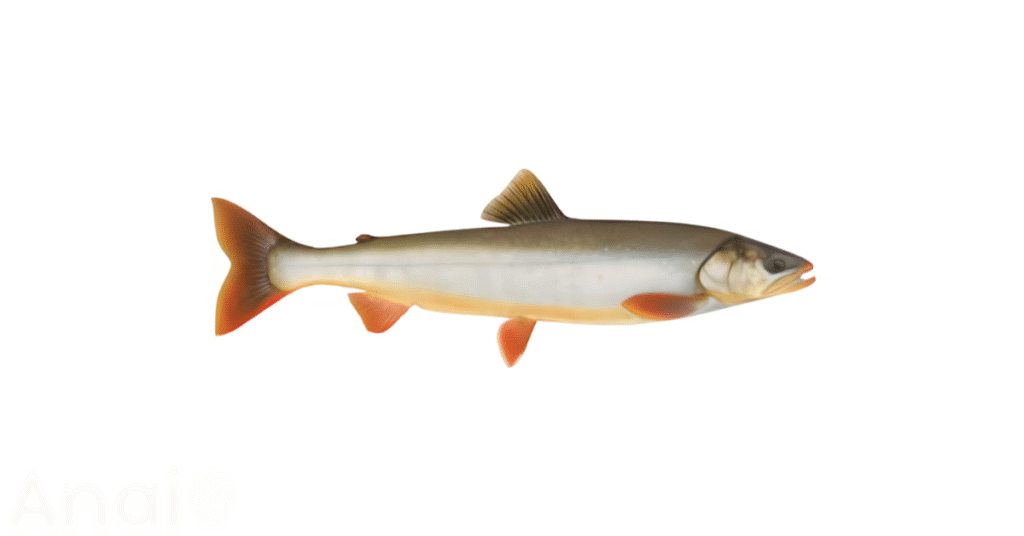
If you don’t have trout on hand or have a dietary restriction, there are many excellent substitutes available. The best choice depends on whether you’re trying to replicate trout’s flavor, texture, or nutritional profile.
Here is a nutritional comparison of popular trout substitutes.
| Substitute | Protein (100g) | Omega-3s | Calories (100g) |
|---|---|---|---|
| Trout | High (20.5g) | High | 119 |
| Arctic Char | High | High | 152 |
| Cod | High (18g) | Moderate | 82 |
| Tofu | Moderate (8g) | Low | 76 |
| Jackfruit | Low (1.7g) | Low | 95 |
Arctic char is often called the perfect substitute for trout. It has a similar delicate, flaky texture and a flavor that’s a cross between trout and salmon. A key benefit is its 1:1 substitution ratio, meaning you can use it in any trout recipe without adjustments (Gray, 2025). Its main drawback is that it can sometimes be more expensive or harder to find than trout.
Salmon is another excellent alternative, though with a bolder flavor and higher fat content. This makes it a great choice for those who want a richer taste. Salmon is extremely versatile and holds up well to grilling and broiling. However, its strong flavor may not be ideal for recipes that call for the mildness of trout.
Cod is a fantastic choice if you want a mild, slightly sweet flavor. Its flesh flakes beautifully, just like trout, making it great for baking, frying, or grilling (Gray, 2025). The main drawback is that it is a leaner fish with a lower omega-3 content compared to trout.
Tilapia is a budget-friendly and widely available substitute. It has a very mild, neutral flavor, which makes it a “blank canvas” for any marinade or seasoning you would use on trout. A drawback is its texture, which is firmer and less fatty than trout, and it also has a lower omega-3 content.
Tofu is a great plant-based substitute. To best mimic trout, use extra-firm tofu that has been pressed to remove excess water. Marinating it in a mixture of lemon juice, dill, and seaweed flakes can create a surprisingly fish-like flavor. The main drawback is that tofu is much lower in protein and contains virtually no omega-3s, so you miss out on some of trout’s key nutritional benefits.
Popular Trout Diets
How to add trouts safely into your diet? Choosing the right diet is important to ensure that you are meeting your nutritional needs while also enjoying the foods you eat. Here are a few of the available trouts-friendly diet options:
- The Mediterranean Diet
- The Pescatarian Diet
- The Paleo Diet
- The Ketogenic (Keto) Diet
| Diet | Key Focus | Benefits | Drawbacks |
|---|---|---|---|
| Mediterranean | Whole foods, fruits, vegetables, lean protein (fish), healthy fats (olive oil). | Excellent for heart health, balanced, sustainable long-term. | Can be higher in carbs than other diets; requires meal planning. |
| Pescatarian | Vegetarian diet that includes fish and other seafood. | High in omega-3s, lower in saturated fat than meat-based diets. | Potential for mercury intake if fish choices aren’t varied and low-mercury. |
| Paleo | Foods available to Paleolithic ancestors: meat, fish, nuts, seeds, vegetables. | Emphasizes whole foods, eliminates processed items, may aid weight loss. | Restrictive (no dairy, grains, legumes), can be difficult to maintain. |
| Keto | Very low-carb, high-fat diet. Puts the body into a state of ketosis. | Effective for rapid weight loss and blood sugar control. | Highly restrictive, can lead to nutrient deficiencies, potential “keto flu”. |
The Mediterranean Diet is consistently ranked as one of the healthiest eating patterns. It emphasizes whole grains, fruits, vegetables, legumes, and healthy fats like olive oil, with fish, like trout, being a primary protein source. It is not a restrictive diet but rather a lifestyle focused on nutrient-dense foods, making it excellent for heart health and highly sustainable.
A Pescatarian Diet is a plant-based diet that incorporates fish and other seafood. This makes trout a centerpiece of the eating plan. Followers get the benefits of a vegetarian diet, such as higher fiber and lower saturated fat intake, plus the significant cardiovascular and brain health advantages of consuming omega-3-rich fish.
The Paleo Diet seeks to mimic the eating patterns of our hunter-gatherer ancestors. It includes lean meats, fish, fruits, vegetables, nuts, and seeds, while excluding grains, legumes, dairy, and processed foods. Trout is an ideal protein for this diet, providing healthy fats and nutrients consistent with the Paleo philosophy.
The Ketogenic (Keto) Diet is a very low-carbohydrate, high-fat diet. The goal is to shift the body’s primary fuel source from glucose to ketones. Trout is a perfect fit for Keto, as it is carb-free and provides high-quality protein and healthy fats, helping individuals meet their macronutrient goals without affecting ketosis.
How to Cook Trouts?
Cooking trout is simple, and its mild flavor lends itself to various preparations. The key is to use methods that preserve its delicate texture and nutritional value.
Grilled trouts is a fantastic method for a smoky flavor. To get crispy skin, pat the trout completely dry and season it well. Use a clean, oiled grill grate or a fish basket to prevent sticking. Grilling is a fast, high-heat method that requires little added fat. Cooking quickly helps preserve more of the delicate omega-3 fatty acids compared to longer cooking methods. A whole trout stuffed with lemon and herbs, grilled for 4-6 minutes per side, is a classic preparation (Riches, 2022).
Baked trouts is one of the easiest and healthiest ways to cook the fish. Baking at a moderate temperature (around 475°F) cooks the fish gently and evenly. Stuffing a whole trout with aromatics like dill and lemon slices before baking infuses the flesh with flavor (Filippone, 2021). This method is excellent for nutrient retention, as it doesn’t require high heat that can degrade fats, and there’s no water to leach out B vitamins.
Broiled trouts offers a way to get a deliciously browned exterior in just a few minutes. Place the fillets skin-side down on a foil-lined sheet, brush with brown butter or oil, and broil about 4 inches from the heat source for 3 to 5 minutes, or until the fish flakes easily (Mitzewich, 2021). Because the cooking time is so short, broiling is one of the best methods for preserving omega-3s and other heat-sensitive nutrients.
Pan-Fried trouts (or pan-seared) gives the fish a wonderfully crispy skin and moist interior. Heat olive oil in a skillet over medium heat, add garlic for flavor, and fry the fish skin-side down for about 5 minutes, then flip and cook for another 2 minutes (Wongkaew, 2021). While this method uses more added fat than others, it’s very quick. Using a healthy oil like olive oil and not overheating it can help preserve the nutritional quality of the fish.
Easy Trout Recipes
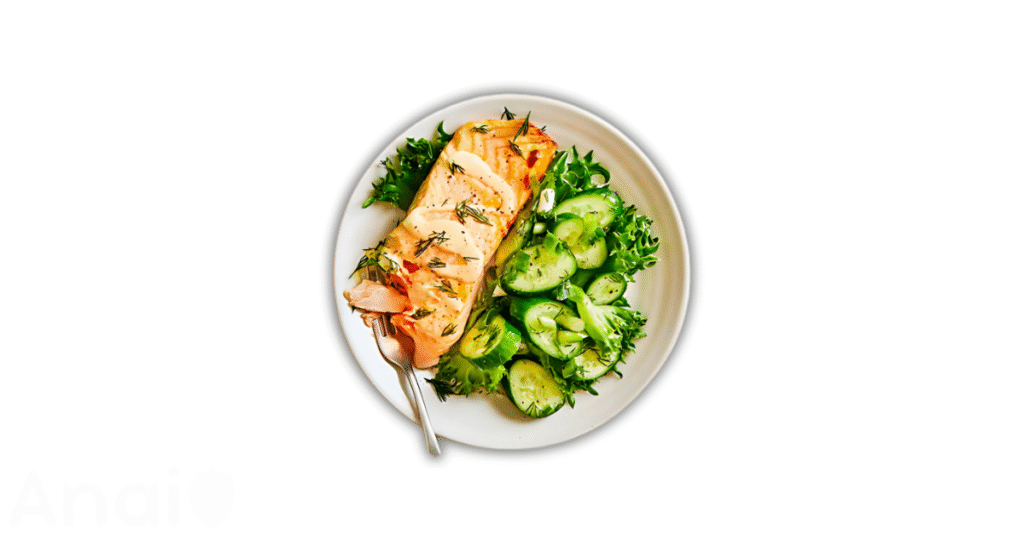
The recipes and ideas below can help you increase your trout intake without compromising on taste or convenience.
Breakfast ideas with trouts
Smoked trout toasts are a simple and elegant breakfast. Spread cream cheese on toasted rye bread or English muffins and top with flaked smoked trout, capers, and fresh dill. This provides a great balance of protein, healthy fats, and complex carbs to start your day.
A smoked trout scramble is a protein-packed alternative to a traditional breakfast. Simply add flaked smoked trout to your scrambled eggs during the last minute of cooking, along with some chives.
Lunch ideas with trouts
A hearty smoked trout chowder makes for a flavorful and filling lunch. This creamy soup often includes potatoes, celery, and onions, with the smoked trout stirred in at the end. It’s a complete meal in a bowl, perfect for a cold day.
A quick trout salad sandwich can be made by mixing flaked cooked trout with mayonnaise or Greek yogurt, celery, and herbs. Serve it on whole-grain bread or in a lettuce wrap for a lighter option.
Dinner ideas with trouts
Herb-roasted whole trout is a visually impressive yet simple dinner. Stuff a whole trout with lemon slices and hardy herbs like rosemary and thyme, roast until tender, and serve with a side of roasted almonds and a simple green salad (Food & Wine Editors, 2024).
Tuscan grilled trout is perfect for a quick and flavorful meal. A simple marinade of olive oil, garlic, herbs, and wine vinegar acts as both a basting liquid and a sauce for the fish. The fillets cook on the grill in about 4 minutes (Food & Wine Editors, 2024).
Pan-seared trout with a lemon-butter sauce is a classic French-inspired dish. The trout is cooked quickly in a pan and served with a simple sauce made from browned butter, lemon juice, and fresh parsley, which perfectly complements the fish’s mild flavor (Mitzewich, 2021).
Simple tips to add trouts to your diet
For busy people who don’t have the time to implement any of the previous meal ideas, there are simple tips to add trouts to their diet:
- Keep pre-cooked smoked trout on hand to easily add to meals.
- Flake leftover baked or grilled trout over a green salad for a quick protein boost.
- Stir flaked trout into pasta with olive oil, garlic, and cherry tomatoes.
- Top a baked potato with a spoonful of Greek yogurt and flaked smoked trout.
- Mix smoked trout into dips or spreads for crackers and vegetables.
- Add trout to your favorite omelet or frittata recipe.
Trout Storage Tips
Knowing how to cook trout is only a part of the equation; it’s equally important to know proper storage tips to keep your fish fresh and make those meals last longer.
Shelf life of trouts
- At room temperature: Fish spoils very quickly. It should never be left at room temperature for more than an hour or two.
- In the refrigerator: Properly stored, fresh, raw trout should be used within one to two days. Hot smoked trout will keep in good condition for up to one week if kept below 4°C (40°F).
- In the freezer: The storage life of good quality frozen trout held at 0°F or lower is four to six months. Commercially vacuum-sealed fish can last from eight to twelve months.
How to store trouts?
The key to storing fresh trout is to keep it as cold as possible without freezing it. As soon as you bring it home from the market, it needs to be refrigerated. Fresh fish has a minimal odor, but to prevent any smells from spreading, you can overwrap it or place it in a sealed container.
It’s also crucial to store raw fish away from any ready-to-eat foods to avoid cross-contamination. Always place it on the bottom shelf of the refrigerator so that any potential drips will not contaminate other foods (Nunez, 2023).
How to refridgerate trouts?
To maintain the best quality, it’s recommended to store fresh trout on ice in the refrigerator.
- Place the trout on a perforated pan or a colander.
- Set this pan inside a larger, solid pan that can catch any melting water.
- Place a resealable plastic bag filled with ice or a reusable ice pack directly on top of the fish.
- Change the ice as it melts.
- Store on the bottom shelf of the refrigerator and use within one to two days.
How to freeze trouts?
If you can’t use your fresh trout within a couple of days, freezing is the best method for long-term storage.
- Rinse the fish under cold water and pat it completely dry with paper towels.
- Wrap the trout tightly in plastic wrap, removing as much air as possible. For extra protection against freezer burn, place the wrapped fish inside a heavy-duty freezer bag.
- Alternatively, you can use the ice glaze method. Place the unwrapped fish on a baking sheet and freeze until solid. Dip the frozen fish in ice-cold water and place it back in the freezer to form a glaze. Repeat a few times until a thick layer of ice is formed, then transfer to a freezer bag.
- Label the package with the date and the type of fish.
- Store in the freezer at 0°F or lower for up to six months.
Signs of Spoilage in trouts
If you’re unsure whether your trout is still good, trust your senses. Here are the tell-tale signs of spoilage:
- A strong, “fishy,” ammonia-like, or sour odor.
- Dull, sunken eyes on a whole fish.
- Flesh that is soft or mushy instead of firm and springy to the touch.
- A slimy, sticky, or milky-colored film on the flesh.
- Loss of the vibrant color and bloom from the skin.
9 Unique Trout Home Remedies
Are there any less-known tips to unlock the nutritious profile of trouts? The following trouts remedies can have a positive effect on overall well-being.
- Trout fertilizer for garden health. Instead of discarding smaller trout or the leftover carcasses after filleting, you can use them as a powerful, organic fertilizer. To do this, dig a hole at least 10 inches deep where you plan to plant, place the fish or fish parts inside, and cover it with garden lime to manage the smell and aid decomposition before filling the hole with soil. This provides a rich source of nutrients for your plants, especially for heavy feeders like tomatoes.
- Crispy trout skin for a collagen snack. Don’t throw away the skin from your trout fillets. Instead, you can bake the skins until they are dry and crispy to create a crunchy, savory snack. Simply lay the skins on a baking sheet, sprinkle with salt, and bake until crisp. This is a great way to consume the healthy fats and collagen found in the skin.
- Trout head broth for joint support. The head and bones of the trout are rich in collagen, gelatin, and minerals. Instead of discarding them, simmer them in water with vegetables and herbs for several hours to create a nutrient-dense fish broth. This broth can be used as a base for soups and is thought to support joint and skin health.
- Trout roe (ikura) for a nutrient boost. Trout roe is a nutritional powerhouse, packed with a concentrated dose of omega-3 fatty acids, vitamin D, and B vitamins. A small spoonful can be used as a remedy to boost nutrient intake. It can be eaten plain or used as a topping for dishes like scrambled eggs or toast.
- Trout bait for harvesting crustaceans. You can use pieces of trout as a highly effective bait for catching other nutritious foods like crabs and crawfish. The strong scent of the fish attracts these crustaceans. Simply place the trout pieces in a bait cage within your crab pot or crawfish trap.
- Trout oil hair mask for shine. The omega-3 fatty acids in trout are excellent for hair health. For a simple remedy, you can mash a small piece of cooked trout with a carrier oil like olive or coconut oil to create a paste. Apply this to your hair as a mask for 20 minutes before washing thoroughly. This can help add moisture and shine to dry hair.
- Smoked trout dip for probiotic support. A smoked trout dip, made by blending flaked trout with a probiotic-rich base like Greek yogurt or kefir cream cheese, can be a delicious way to support gut health. The combination provides protein, healthy fats, and beneficial bacteria in one easy-to-eat snack.
- Trout poultice for minor skin irritations. Historically, the skin of certain fish has been used as a poultice for minor burns and scrapes due to its collagen content, which can help soothe the skin. While this is a traditional remedy and should be used with caution, a small piece of clean trout skin can be placed on a minor irritation to provide a cooling effect.
- Trout-infused pet food topper for a healthy coat. The healthy fats in trout aren’t just good for humans. Flaking a small amount of unseasoned, cooked trout over your dog or cat’s food can serve as a remedy for a dull coat, helping to make it shinier and healthier thanks to the omega-3s.
Trouts and Weight Management

There are multiple health benefits, and home remedies using trouts, but what is their role in weight management? This section will analyze trouts potential impact on weight loss, low-calorie diets, satiety, and metabolism.
Can trouts help with weight loss?
Yes, trout can be a valuable component of a weight loss diet. Its high protein content and healthy fats work together to promote weight management. Protein-rich foods are known to enhance feelings of fullness, which can lead to a natural reduction in overall calorie intake. Furthermore, the omega-3 fatty acids found in trout may help in reducing inflammation, a factor that is often linked with obesity and metabolic dysfunction.
Trouts in low-calorie diets
Trout is an excellent choice for a low-calorie diet because it is nutrient-dense. A 100-gram serving of trout contains only about 119 to 148 calories, yet it is packed with essential nutrients. This allows a person on a calorie-restricted diet to get a significant amount of high-quality protein, vitamins like D and B12, and important minerals without consuming a large number of calories. This makes it easier to meet nutritional needs while maintaining a calorie deficit for weight loss.
Trouts and satiety
The feeling of fullness, or satiety, is crucial for weight management, and trout excels in this area. The high protein content is the main reason for this. Studies published in journals like The American Journal of Clinical Nutrition have consistently shown that protein is the most satiating macronutrient. Some research also suggests that fish protein, in particular, may be more satiating than other protein sources like beef. Eating a serving of trout can help you feel full and satisfied for a longer period, reducing the likelihood of snacking on less healthy, high-calorie foods between meals.
Trouts and metabolism
Trout can also have a positive effect on metabolism. The body uses more energy to digest protein than it does for carbohydrates and fats—a phenomenon known as the thermic effect of food (TEF). With nearly 21 grams of protein per 100g serving, trout can give your metabolism a slight boost after a meal. Additionally, the omega-3 fatty acids in trout have been studied for their role in metabolic health. Research suggests that omega-3s can help improve insulin sensitivity and reduce the chronic inflammation associated with metabolic syndrome.
Trouts for Health Conditions
While weight management is important, do trouts have an effect in more serious health conditions? Here’s what the scientific literature has to say:
Trouts and diabetes
Trout is an excellent food for managing and potentially preventing type 2 diabetes. Because it contains zero carbohydrates, it does not cause a spike in blood sugar levels. Its high protein content also helps with glycemic control. The anti-inflammatory properties of its omega-3 fatty acids can help combat the chronic inflammation associated with insulin resistance and diabetes (Proietti, 2023).
Trouts and heart health
Trout’s benefits for heart health are significant and well-documented. It is rich in omega-3 fatty acids, EPA and DHA, which are crucial for cardiovascular function. A typical 159-gram fillet contains around 1,291 mg of omega-3s (Joseph, 2023). Research shows these fats can lower triglycerides, reduce blood pressure, and slow the growth of atherosclerotic plaque (Lindberg, 2020). In the “GISSI Prevention Trial,” heart attack survivors who took a 1-gram capsule of omega-3 fats daily for three years were less likely to have a repeat heart attack, stroke, or die of sudden death than those who took a placebo (Rudrappa, 2025).
Trouts and digestive issues
While trout isn’t a specific remedy for digestive ailments, it is a highly digestible protein source. Unlike heavier, high-fat meats, the lean protein in trout is gentle on the digestive system. Furthermore, the anti-inflammatory effects of omega-3s can contribute to a healthier gut environment by reducing systemic inflammation, which is often linked to digestive issues.
Trouts and inflammation
Chronic inflammation is a key driver of many serious diseases, including heart disease and arthritis. Trout is a powerful anti-inflammatory food due to its high omega-3 content. These fatty acids help reduce the body’s production of inflammatory substances. A single trout fillet also provides 20 mcg of selenium, which is nearly 30% of the RDI. Selenium is a mineral that helps produce antioxidant enzymes, which fight oxidative stress and further reduce inflammation in the body (Joseph, 2023).
Trouts and cancer prevention
While no single food can prevent cancer, some nutrients in trout are associated with a reduced risk. Trout is an exceptional source of Vitamin D, with a 100g serving providing over 100% of the daily recommended intake (Joseph, 2023). Vitamin D plays a significant role in calcium metabolism and cellular growth, and some studies suggest it may offer protection from certain types of cancers (Rudrappa, 2025). The anti-inflammatory properties of omega-3s also play a role in creating an environment less conducive to cancer growth.
The evidence strongly suggests that the rich nutritional profile of trout, particularly its high omega-3 fatty acid content, offers substantial benefits for managing and reducing the risk of several major health conditions.
| Health Category | Benefits | Type of Study | Quality of Evidence | Sources |
|---|---|---|---|---|
| Heart Health | Reduced risk of repeat heart attack, stroke, and sudden death. | Large-scale clinical trial (GISSI Prevention Trial). | High | Rudrappa (2025) |
| Inflammation | Reduction in systemic inflammation and oxidative stress. | Nutritional Science Reviews. | Moderate to High | Proietti (2023); Joseph (2023) |
| Diabetes | Improved glycemic control due to zero carbs and high protein. | Nutritional analysis and established dietary principles. | High | Lindberg (2020) |
| Brain Health | Supports fetal brain development; may improve cognitive function. | Observational studies and health guidelines (ACOG). | Moderate to High | Lindberg (2020) |
| Bone Health | High Vitamin D content aids calcium absorption and strengthens bones. | Nutritional Science Reviews. | High | Joseph (2023); Lindberg (2020) |
Trout Nutrition: Takeaways
This article has provided a comprehensive look at the world of trout, covering topics like 10 research-backed health benefits of trouts, trout nutrition facts, trouts risks and side effects, trouts substitutes, popular trout diets, trout storage tips, 9 unique trout home remedies, trouts and weight management, and trouts for health conditions.
Here are some of the most interesting takeaways:
- Trout is one of the “cleanest” fish you can eat, with a mean mercury concentration of just 0.071 parts per million (PPM).
- A single 100-gram (3.5 oz) serving of trout provides over 100% of your daily recommended intake of Vitamin D.
- The same serving size of trout also delivers 74% of your daily Vitamin B12 needs.
- Trout is completely carb-free and cholesterol-free, making it ideal for low-carb diets and heart-healthy eating plans.
- The omega-3s in trout are incredibly powerful; studies like the GISSI Prevention Trial linked their consumption to a lower risk of repeat heart attacks and strokes.
- Fresh, raw trout keeps for only 1-2 days in the refrigerator, emphasizing the need for proper and timely storage.
This content was last updated in December 2025.
Follow Anai.ai to stay informed about the latest nutrition and well-being news, tips and articles.
Trout Nutrition FAQs
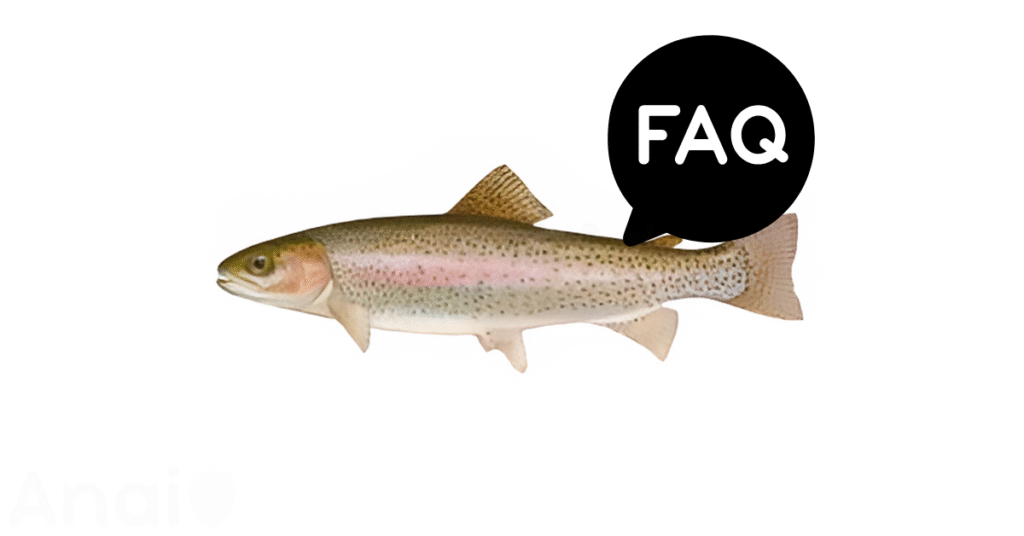
This section offers quick, fact-based answers to the most common inquiries about trout. It addresses everything from health benefits and dietary concerns to safety for pets. This guide provides practical, data-driven information on consumption and storage.
What are trouts good for?
Trout is incredibly good for supporting overall health due to its rich nutritional profile. It is an excellent source of lean protein, providing about 20.5 grams per 100g serving, which is essential for muscle repair and growth. Trout is also packed with omega-3 fatty acids, which are vital for heart and brain health, and contains key nutrients like niacin and Vitamin B12, which help convert food into energy and support nerve function.
Are trouts healthy?
Yes, trout is exceptionally healthy and considered one of the most nutrient-dense fish you can eat. A single fillet provides more than 100% of the recommended daily intake for Vitamin D and 74% for Vitamin B12. Furthermore, it is prized for being a “clean fish” with very low levels of mercury compared to other predatory fish. Its balanced profile of high-quality protein, essential fats, and vitamins makes it a fantastic addition to a healthy diet.
Are trouts fattening?
Trout is not considered fattening and is an excellent choice for weight management. A 100-gram serving of rainbow trout contains only about 119 calories and just 3.5 grams of fat, most of which are beneficial omega-3 fatty acids. Its high protein content also promotes satiety, helping you feel full and satisfied, which can prevent overeating. This combination of low calories and high protein makes it a great alternative to higher-fat meats.
Who should avoid trouts?
While trout is healthy for most people, individuals with a fish allergy should avoid it completely to prevent reactions that can range from mild hives to severe anaphylaxis. Those who are susceptible to gout may also want to limit their intake of oily fish like trout. Additionally, while trout is low in contaminants, people who eat locally caught fish should check with their local health or wildlife department for specific consumption advisories regarding pollutants like PCBs or mercury in certain waterways.
Can I eat trouts daily?
Eating trout daily is generally considered safe for most people due to its very low mercury content. The USDA recommends consuming about 8 ounces of low-mercury fish per week, and trout easily fits within these guidelines. While daily consumption is unlikely to be harmful, nutrition experts typically advise a varied diet to ensure you get a wide range of nutrients from different food sources.
Can dogs eat trouts?
Yes, dogs can eat trout, and it can be a healthy part of their diet when prepared correctly. The fish must be thoroughly cooked, deboned, and served plain without any seasonings like salt, garlic, or onions. Never feed your dog raw trout, as it can contain a parasite that causes “salmon poisoning,” a potentially fatal condition for dogs. When cooked properly, trout is a great source of protein and omega-3 fatty acids, which can improve your dog’s coat and skin health.
Can cats eat trouts?
Yes, cats can eat trout, but it must be cooked thoroughly, deboned, and served plain without any seasonings. Raw trout is not safe for cats as it can contain thiaminase, an enzyme that destroys thiamine (Vitamin B1), which is essential for feline neurological health. Cooked trout offers high-quality protein and omega-3 fatty acids, which can support a cat’s skin, coat, and overall well-being.
How long do trouts last in the fridge?
Fresh, raw trout should be cooked within one to two days when stored properly in the refrigerator at a temperature of 40°F (4°C) or below. Storing it on a bed of ice can help maintain its quality during this short period. Once cooked, leftover trout will remain good for up to three to four days if kept in an airtight container.
Can you freeze trouts?
Yes, you can absolutely freeze trout to preserve it for longer periods. For optimal quality, fresh trout should be frozen quickly and will keep well for four to six months at a consistent temperature of 0°F (-18°C). Properly wrapping the fish in airtight packaging is crucial to prevent freezer burn, which can affect its taste and texture.
How to tell if trouts are bad?
You can tell if trout has gone bad by checking its smell, appearance, and texture. A strong, sour, or ammonia-like odor is the most definitive sign of spoilage, as fresh fish should smell mild and clean. Other indicators include dull, sunken eyes, a slimy or sticky film on the flesh, and a soft, mushy texture that does not spring back when pressed.
How long are trouts good for?
The shelf life of trout depends entirely on its storage method. In the refrigerator, fresh trout is only good for 1 to 2 days, while cooked trout can last 3 to 4 days. Freezing extends its life significantly, keeping it in good condition for 4 to 6 months. Smoked trout, when properly refrigerated, can last for about one week.
How to keep trouts fresh?
To keep trout fresh, it’s essential to store it in the coldest part of your refrigerator, ideally at a temperature just above freezing, around 32°F (0°C). The best practice is to place the fish on a bed of crushed ice in a perforated container set over another pan to catch the melting water. This method slows bacterial growth and can keep the fish in prime condition for up to two days.

